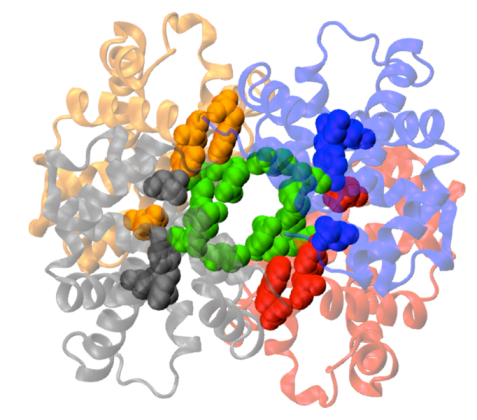MLZ is a cooperation between:
 > Technische Universität München
> Technische Universität München > Helmholtz-Zentrum Hereon
> Helmholtz-Zentrum Hereon
 > Forschungszentrum Jülich
> Forschungszentrum Jülich
MLZ is a member of:
 > LENS
> LENS > ERF-AISBL
> ERF-AISBL
MLZ on social media:

MLZ (eng)
Lichtenbergstr.1
85748 Garching
10.07.2012
Optimized haemoglobin of human being and duckbill platypus
Neutrons reveal how the oxygen-transporting protein adapts to the body temperature of different species.

Structure of chicken hemoglobin: The four gray, yellow, blue and red subunits in the inner part, in which the oxygen binding takes place, are composed of different amino acids depending on the species and determine the temperature-dependent elasticity of the whole molecule. (Quelle: Forschungszentrum Jülich)
For a healthy human being a body temperature of about 37 degrees Celsius is ideal, but for a duckbill platypus 33 degrees are enough. Jülich Neutron Researchers found out, along with French and Australian colleagues, how the haemoglobin of different species has adapted to the different body temperatures during evolution. It is such that it can optimally carry the oxygen at the respective temperature from the lung into the cells. Among others, the measurements were carried out at the Research Neutron Source Heinz Maier-Leibnitz (FRM II).
The researchers have examined the haemoglobin of several species, including a duckbill platypus, which has the lowest body temperature of selected vertebrates (33°C), a bird, an ordinary chicken with a very high body temperature of 42.8°C, and a poikilothermic crocodile (25 – 34°C). In order that the oxygen molecules can reach the four iron atoms in haemoglobin, the haemoglobin unfolds partially and gets sufficiently flexible, without losing its structural integrity. From previous research it has already been known that the elasticity of the haemoglobin of different species adapts to different body temperatures. But which temperature-sensitive part of the haemoglobin has caused this evolutionary adaptation, remained open until now.
The key to this open question, as described in the Journal of the Royal Society Interface, are chemical differences between the different haemoglobins. While all are composed of amino acids, the types of amino acids and their order vary. The research focused on amino acids between small holes of the haemoglobin, known as caves, of which it is known that they play a role in regulating the oxygen absorption. The variation of these amino acids directly affects the stiffness of the whole protein and was selected by evolution so that the efficiency concerning the body temperature of each species is optimized.
“We have noticed a direct correlation between the flexibility of these proteins and the mean body temperature of the different species in which they are effective,” explains Dr. Andreas Stadler from Forschungszentrum Jülich. “Haemoglobin is working as a highly sensitive molecular thermometer for body temperature. Our findings may have important implications for research on red blood cells in biology, bioengineering and biomedical interest because they explain how evolution has optimized the vital role of haemoglobin in different species.”
The flexibility and rigidity of the different haemoglobins have been measured using neutron scattering experiments at the Research Neutron Source Heinz Maier-Leibnitz (FRM II) in Garching and at the ILL in Grenoble, two of the world’s most intense neutron sources. Neutron scattering has been chosen because with this method the movement of complex structures can be accurately measured without destroying the very delicate samples. In order to find out which amino acids are responsible for the variation of stiffness, complementary computer simulations were carried out at the CNRS in Paris.
Original publication:
A. M. Stadler, C. J. Garvey, A. Bocahut, S. Sacquin-Mora, I. Digel, G. J. Schneider, F. Natali, G. M. Artmann, and G. Zaccai
Thermal fluctuations of haemoglobin from different species:
adaptation to temperature via conformational dynamics
J R Soc Interface 2012 (Vorveröffentlichung online, 13. Juni 2012)
MLZ is a cooperation between:
 > Technische Universität München
> Technische Universität München > Helmholtz-Zentrum Hereon
> Helmholtz-Zentrum Hereon
 > Forschungszentrum Jülich
> Forschungszentrum Jülich
MLZ is a member of:
 > LENS
> LENS > ERF-AISBL
> ERF-AISBL
MLZ on social media:


